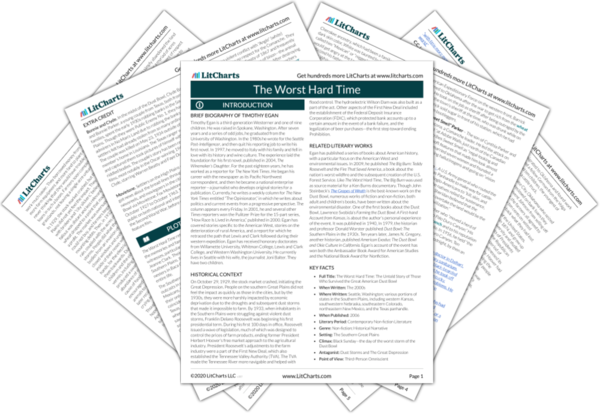Exodusters Quotes in The Worst Hard Time
Chapter 7 Quotes
When the native sod of the Great Plains was in place, it did not matter if people looked twice at a piece of ground. Wind blew twenty, thirty, forty miles an hour, as always. Droughts came and went. Prairie fires, many of them started deliberately by Indians or cowboys trying to scare nesters off, took a great gulp of grass in a few days. Hailstorms pounded the land. Blue northers froze it so hard it was like broken glass to walk on. Through all of the seasonal tempests, man was inconsequential. As long as the weave of grass was stitched to the land, the prairie would flourish […] The grass could look brown and dead, but beneath the surface, the roots held the soil in place; it was alive and dormant […] When a farmer tore out the sod and walked away […] It could not revert to grass, because the roots were gone. It was empty, dead, and transient.
Chapter 25 Quotes
Elsewhere in 1938, the recovery and the energy of the New Deal had run out of steam. More than four million people lost their jobs in the wake of government cutbacks, and the stock market fell sharply again. Some of the gloom that enveloped the country at midterm in President Hoover’s reign was back. In the Dust Bowl, the fuzz of a forced forest and the re-tilling of tousled dirt did not stop the wind or bring more rain, but it was a plan in motion—something—and that was enough to inspire people to keep the faith. As Will Rogers said, “If Roosevelt burned down the Capital we would cheer and say, ‘Well, we at least got a fire started anyhow.’” The High Plains had been culled of thousands of inhabitants […] But as the dirty decade neared its end, the big exodus was winding down. The only way that folks who stayed behind would leave now, they said, was horizontal, in a pine box.












